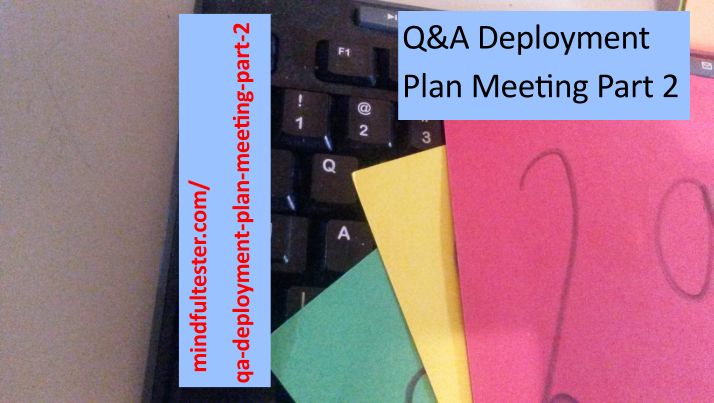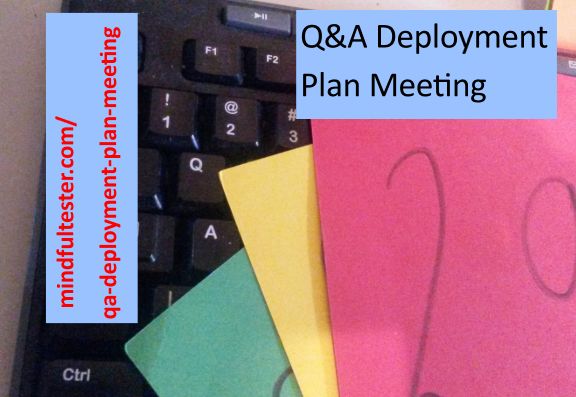[Note from the author: after some fact checking I discovered that I used the Red Card in a wrong way in this blog post. The red card must be used to raise issue like low volume or high temperature in the room, which can lower the quality of the gathering of information. For normal interruptions the yellow card should be used.
This basically means that I had to rewrite the blog post on certain points. This task was more complex than I had expected. The whole flow of arguments had to be restructured while preserving the spirit of this post. So I only added this note.]
Facilitator: Thank you for joining in once again. Han Toan has already answered a lot of questions about Deployment Test Meeting over here. These questions were raised after reading his writing about his Deployment Plan Meeting.
Questions are still coming in. I’ve got green cards from numbers 38, 95, and 12. Number 38, you can ask your question.
Attendee number 38: Did you take the communication styles of the attendees in the meeting into account?
Speaker: During the preparation of the meeting I sent a concept version of the Deployment Plan to all the attendees. So the techies could study all actions and make notes on it.
The project leaders also brought their hard copy. They used it to note down important actions. I would not be surprised, that it was also used for time tracking: will all actions be discussed during the meeting? There were also managers carrying small notebooks.
One of the biggest advantages of the beamer was, that changes were shown. Next to verbal clarifications.
Facilitator: I’ve got green cards from numbers 95, and 12, and 23. Number 95, you can ask your question.
Attendee number 95: A Deployment Plan looks like a scripted test case. People say, that there is no need to make a test case, if it is used once. So why the hassle?
Speaker: I consider the Deployment Plan as a checklist of ordered and dependent actions. Still people might consider it as a time consuming artifact or test case.
Due to the complexity of the system and the number of involved parties it is handy to have some kind of script ready for use. Weeks before the deployment there was enough time to think things over.
Let’s assume I have the idea to have a dinner with my team. There are practical things like the location and time period. But there are also other things to take into account: is the food not too hot by the use of peppers? Or is vegetarian food available? If this is the first time, then it takes some time to arrange it.
Facilitator: I’ve got green cards from numbers 12 and 23. Number 12, you can ask your question.
Attendee number 12: At the beginning of the meeting I would start with introductions. I missed that part in your story.
Speaker: To me it is a logical step, so I skipped it in my writing. But I agree with you, that a round of introductions is needed. I think, that it is good to realise, that you work with human beings with needs and feelings.
Facilitator: Number 23
Attendee number 23: Were enough technical people attending?
Speaker: It was a prerequisite for the meeting. Technical actions had to be discussed. A manager can be helpful, but a techie knows the implications.
To be frank with you, I have to add, that one system administrator was not present. I talked with him about all relevant actions for him. Then I got the assurance, that I could call him during the meeting.
Facilitator: A yellow card from number 38.
Attendee number 38: Were all involved managers involved?
Speaker: Yes, they were. It was relevant to get fast approval for additional actions. During the meeting a techie could look at his manager for approval.
Facilitator: At the moment there are no more questions on the stack. This is your last chance. Okay. I see number 2. Number 7 and number 9. Number 2.
Attendee number 2: What was your Lesson Learned from this meeting?
Speaker: During the meeting I also updated the Deployment Plan myself. This way costed me a lot of energy, because I also wanted to see, how people reacted. The next time I let someone else update the Deployment Plan.
Facilitator: Number 7.
Attendee number 7: Why do you share this story?
Speaker: For me it was a logical step to set up a meeting and be a chairman. It looked effortless to lead this process. It was not completely the case. What is important, that I want to share the steps and actions I took.
Facilitator: Number 2.
Attendee number 2: Why do you share this QA?
Speaker: This is my way to exercise answering questions. It is a quite thorough one, because it can strengthen my story. Sometimes I use the answers, the next time I tell my story.
Furthermore it shows, how K-cards can be used.
Facilitator: There are no more cards on the stack. I hope you had some refreshing blog posts about a deployment plan and a meeting. Next time there will a blog post about more technical stuff.
Have a nice day (and fruitful Deployment Plan Meeting:).


